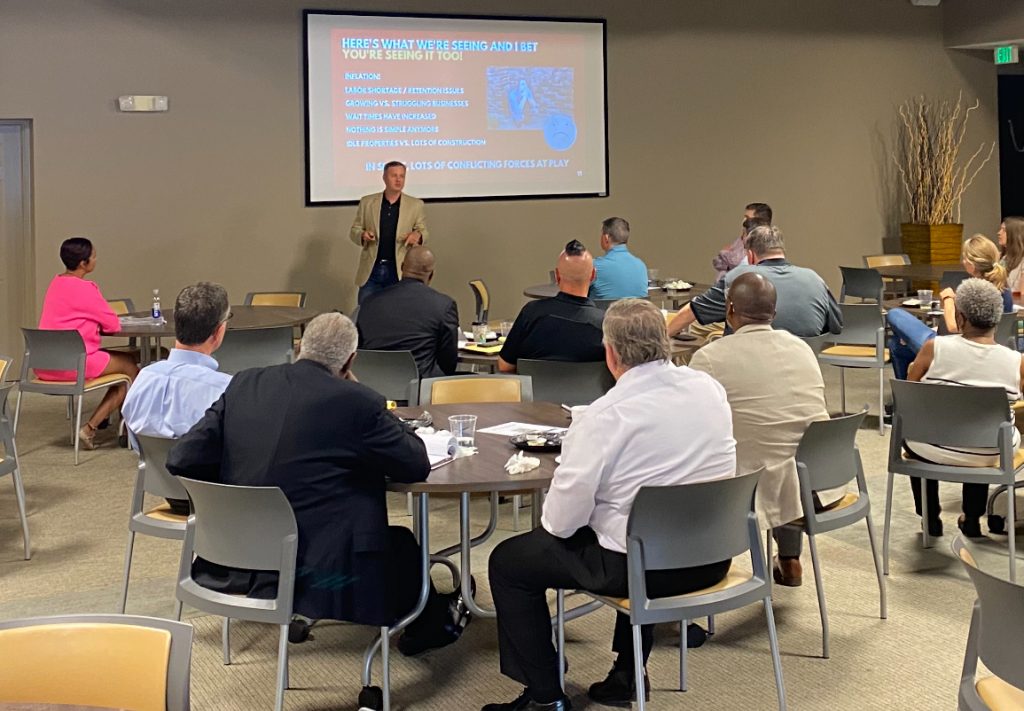Let me start out this article by getting to the main point — 2024 is going to be a year of change and adjustment for businesses of all sizes, but particularly small, local businesses.
We all had to adjust to the changes brought on by COVID a few years ago. I think most of us thought things would go back to “normal” after that, but they haven’t. Change is part of life, but it seems change is happening at an accelerating rate.
Here in our local community, I see how rapid change has really impacted some folks in a very positive way, but it’s really left others in the dust. As a 25-year resident of the area (and my wife a lifelong resident), I’m probably somewhere in the middle of those two extremes. Some areas of our community are not even recognizable (which isn’t necessarily bad) from what they looked like just a few years ago, while other areas haven’t changed in 100 years.
My company was started in 2003 because I wanted to make some changes in my life. Change can be uncomfortable, but it also presents opportunities, as it has for me and my family. It’s been my experience that small businesses have the ability to pivot and react to change quicker than larger organizations. That doesn’t mean it’s simple, but it’s easier to change a 10-person company than it is a 10,000-person organization.

Like most small business owners, I’m generally grounded in the present while looking ahead towards the future. I’m often asked what I see as future trends, but my answers normally come out as informal dialogue with colleagues and other community leaders in an informal setting.
In this article, I’m going to put my “predictions” into writing. We can see how well I nailed it at the end of the year. Most of the news and economic predictions are provided at a national or state level. I’m going to focus on change as it applies to our small, local businesses like mine.
1.Artificial Intelligence (AI) will become an important part of small business operations.
Last year, ChatGPT showed up out of nowhere and not only caught the tech giants off guard, but it also surprised most of us. Seemingly overnight, we all had access to a free tool that we could use to generate content and answer questions using regular language. We’ve had access to other forms of AI for several years now, but this ability for AI to create things is new (aka generative AI).
Most organizations, mine included, tried out some things using AI and I’ve written about that previously. This year, AI is going be less of a toy and more of an important tool used to increase productivity, reduce costs, and speed up time-to-benefit. People who learn how to use it will become more productive and valuable. Businesses (and employees) who don’t catch on or refuse to use it will get left behind.
For those old enough to remember, this is very similar to the desktop computer (PC) revolution in the 80s. Prior to the PC, mainframe computers were in big rooms operated by specially trained staff. Once the PC came out, everyone had one on their desktop. It’s that way with AI right now. Wading through the hype to figure out how to safely and securely implement AI into key business operations is going to be a high priority for most organizations this year.
According to IBM in the recently published 5 Trends for 2024,
“People who use AI will replace people who don’t”.
2. Creativity will become the number one job skill for businesses of all sizes, particularly small businesses.
Matt Candy, global managing partner in generative AI at IBM, has said, “the jobs of the future will be filled by those who can work with AI using language and creative thinking. AI is ‘learning to talk our language’”. Yes, I think AI is a big enough deal that my top two trends deal with it. Whereas my first trend was about the technology itself, this one is about people.
Creative people will find novel ways to innovate, ideate, and generate things using AI technology as a tool, much like an artist uses a palette and paintbrush. People who just crank out AI content for marketing materials, blogs, social media posts, and other purposes are actually going to hurt their organizations.
I don’t know about you, but I’m already tired of AI-generated advertisements, photo enhancements, and bland robot-written content. In this new age of robotic content, people are going to crave human-generated creations. As tempting as it is to fill up a blog with ChatGPT written content, don’t. AI detection systems are freely available and Google favors people-first content.
3. Customer service will continue to be a challenge for most businesses.
No matter what kind of business you have, some customers (typically older ones) expect direct human interaction via phone calls, meetings, and in-person service counters. Providing in-person service is not as easy as it used to be. Ask any business leader and one of their top challenges is workforce development, whether you’re trying to hire servers or engineers.
Not only is it hard to attract qualified labor, but it’s very difficult to keep up with wages. I’ve seen our own payroll costs double in the last three years, mostly driven by inflation. This is why many businesses opt for automated customer service solutions such as online help, chatbots, and order-entry kiosks. Younger people seem to be more comfortable with these types of solutions and, in many cases, would rather have a self-service option than have to speak to someone on the phone.
If you’re a business leader, it’s not either-or, it’s both — you have to be able to provide both “live customer service” and automated “self-service”. Speaking from experience, we love interacting with our customers, but it can be challenging because everyone wants to interact with us in a different way — email, web portal, text message, phone call, or appointment. This stratification of customer service models is especially true in our community which tends to skew towards an older, more traditional population. As a middle-aged person, I can operate comfortably in both models of customer service, but it doesn’t mean that it’s easy or cost-effective.
4. Agile business models will work their way into many industries.
Armed with better data and automated processes, businesses will be more agile in responding to changing market conditions. Slow-moving organizations (and people) will continue to fall behind. Leaders will be challenged with the need to be responsive, but not overreact.
As a society, we are increasingly becoming bored and impatient. We want what we want, when we want it. Most of us have a smartphone that enables us to get immediate gratification for reservations, information lookups, communication, and product ordering. Technology will enable quicker feedback and execution of business strategies.
It used to be that only large businesses had access to predictive models to associate something like ad spend to customer acquisition. Those types of analytics are now available to the smallest of businesses. In particular, AI is ruthlessly effective at spotting patterns and trends in data.
I think most businesses are already implementing agile business models and it’s my hope that the government catches up. Here in our community, we are fortunate in that most of our municipalities and governmental organizations are trying to find ways to be more responsive to the needs of its citizens. As long as change is tempered with the desire for improvement, I think being agile is a good thing for any organization.
5. A return to profitability will become the number one goal for most businesses.
At first blush, that seems self-evident. I don’t know of a single business or non-profit that wants to run at a loss. On the other hand, I know many business leaders, especially local ones, who put the needs of their people above the financial needs of the organization during the “survival” mode of the pandemic.
I’m proud of our local business and community leaders who came together during those times. I personally enjoyed participating in some of the “support local” business initiatives of the times. We live in a new era. After the bumpy ride of the pandemic, businesses began to recalibrate by hiring new people and implementing new technologies.
This, among other factors like supply chain disruptions and the current wage-price spiral, has contributed to inflation. Inflation tends to cool off the economy. While some industries thrive no matter what’s going on with inflation, it’s been my observation here locally that it’s caused a cooling off in the demand for many of the products and services from our B2C (business-to-consumer, retail) and B2B (business-to-business) small businesses.
In short, people are eating at home more and spending less money. You don’t have to be an economist to see the impact of inflation here in our community. Returning to profitability is important so that businesses can cover increased expenses (labor, materials, operating costs) and maintain operational viability.
So there you have it, my top five small business trends for 2024. Obviously, there’s a lot more going on in our community and the world at large than what I’ve listed. Change is not easy, but the rapid and thoughtful adoption of AI has the potential to really help businesses, particularly small businesses, grow to new levels of success. This year will see the creative, human-centric use of technology usher in a new era of agility and profitability, just as the PC did for those of us back in the ’80s. The journey will be bumpy. Organizations that figure out how to thrive in this environment will come out on top. Others who are slow to learn and adapt will get left behind.
Yes, jobs will be lost or reclassified, but new jobs will also be created. That’s not a bad thing, although growth sometimes hurts. The web and internet didn’t exist when I was in college, yet for the past twenty years, I’ve been running a marketing agency that got its start doing web design. There will be new jobs and business opportunities in the next few years that haven’t even been thought of today.
Being a leader is never easy, and making decisions that may negatively impact people can be tough. Focusing on the greater good sometimes necessitates making a change that “rips the band-aid off” so that the pain is temporary. I don’t know what kind of changes you are considering for this new year, but whatever they may be, I wish you much success and know that I’m out there with you. A friend of mine recently shared the following quote with me:
“As a leader, you do what is right, not what is convenient and comfortable.”
[Joe Domaleski, a Fayette County resident for 25 years, is the owner of Country Fried Creative – an award-winning digital marketing agency located in Peachtree City. His company was the Fayette Chamber’s 2021 Small Business of the Year. Joe is a husband, father of three grown children, and proud Army veteran. He has an MBA from Georgia State University and enjoys sharing his perspectives drawing from thirty years of business leadership experience. Sign up for the Country Fried Creative newsletter to get marketing and business articles directly in your inbox. ]









Leave a Comment
You must be logged in to post a comment.